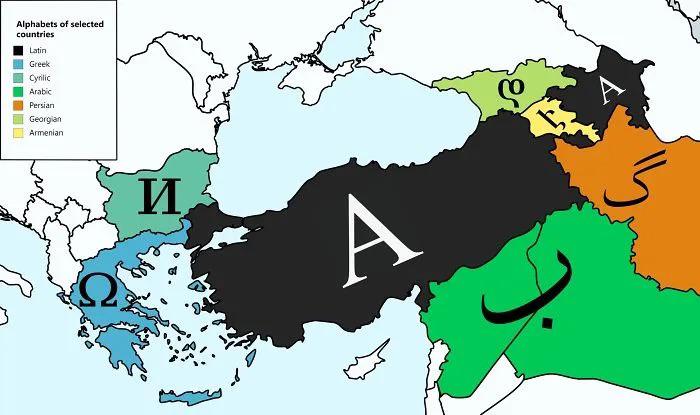Turkey Border Countries and Alphabets Map


David Chen
Data Visualization Specialist
David Chen is an expert in transforming complex geographic datasets into compelling visual narratives. He combines his background in computer science ...
Geographic Analysis
What This Map Shows\nThis map highlights Turkey's unique geographical position as it shares its borders with seven countries and features seven different alphabets. Nestled at the crossroads of Europe and Asia, Turkey is not only a bridge between these two continents but also a melting pot of cultures, languages, and histories. The visualization presents an overview of Turkey's neighboring nations—Greece, Bulgaria, Georgia, Armenia, Azerbaijan, Iran, and Iraq—and the various scripts used in these countries, illustrating the rich tapestry of linguistic diversity that characterizes the region.
Deep Dive into Turkey's Borders and Alphabets\nTurkey's geographical landscape is a fascinating subject in its own right. Bordered by eight nations, with the Aegean Sea to the west, the Mediterranean Sea to the south, and the Black Sea to the north, Turkey acts as a significant boundary between diverse cultures and languages. Its strategic location has historically made it a crucial site for trade, migration, and conflict.
The seven countries that share a border with Turkey each bring their linguistic heritage, leading to a compelling exploration of alphabets. For instance, Turkish is written in the Latin alphabet, a result of the reforms initiated by Mustafa Kemal Atatürk in the 1920s. However, just across the border in Greece, the Greek alphabet is used, which has its roots in ancient history dating back to the 8th century BC.
Moving eastward, the Armenian language utilizes an entirely unique script developed in the early 5th century, while Azerbaijani employs the Latin alphabet, similar to Turkish, although it has historically used both Cyrillic and Arabic scripts as well. Further along, the Persian alphabet is utilized in Iran, which has been adapted from Arabic, reflecting the historical influences that shape its language.
Interestingly, Iraq's Arabic script is another layer of complexity in this linguistic landscape. Arabic, with its rich literary tradition, is used widely across the nation, while Kurdish, which is also spoken in parts of Turkey, employs both Latin and Arabic scripts depending on the region.
Each of these scripts not only represents a language but also reflects the culture, history, and identity of the people who speak them. With approximately 80 million people living in Turkey and millions more in its neighboring countries, the interplay of languages and alphabets is a vivid illustration of the region's cultural richness.
Regional Analysis\nDiving deeper into the regions bordering Turkey, we can observe some fascinating contrasts. For instance, in the northwest, Turkey’s border with Greece is characterized by a blend of Mediterranean influences and a significant historical connection that dates back to the Byzantine and Ottoman empires. The predominant use of the Greek alphabet here highlights the enduring legacy of Hellenistic culture.
In contrast, the eastern border with Armenia and Azerbaijan showcases a different linguistic landscape. The rich history of the Armenian language, with its distinct script, stands in stark contrast to the Latin-based Azerbaijani. Here, the cultural and political tensions also add another layer to the understanding of these alphabets, as they are symbols of national identity in often-contested regions.
Meanwhile, in the south, Turkey's border with Iraq provides insight into the complexities of language as a tool for identity. The Arabic script is prevalent, but the presence of Kurdish speakers who use both Arabic and Latin scripts reflects the region's ethnic diversity and ongoing socio-political dynamics.
Significance and Impact\nUnderstanding the borders and alphabets of Turkey holds significant implications for a myriad of fields, from linguistics and cultural studies to international relations. The linguistic diversity represented in this map is not merely academic; it has real-world consequences in terms of diplomacy, trade, and social interactions.
As globalization continues to shape the world, the cultural exchanges facilitated by Turkey's borders will likely evolve. The increasing prevalence of English, for instance, is becoming more common as a lingua franca, which could influence future generations' language use across these borders. However, the preservation of indigenous languages and scripts remains critical for maintaining cultural heritage.
In conclusion, the relationship between Turkey, its neighboring countries, and their respective alphabets provides a rich field for exploration. The map serves as a visual reminder of the intricate tapestry of languages and cultures that not only define Turkey but also highlight the importance of understanding geopolitical relationships in a rapidly changing world.
Visualization Details
- Published
- October 22, 2025
- Views
- 30
Comments
Loading comments...